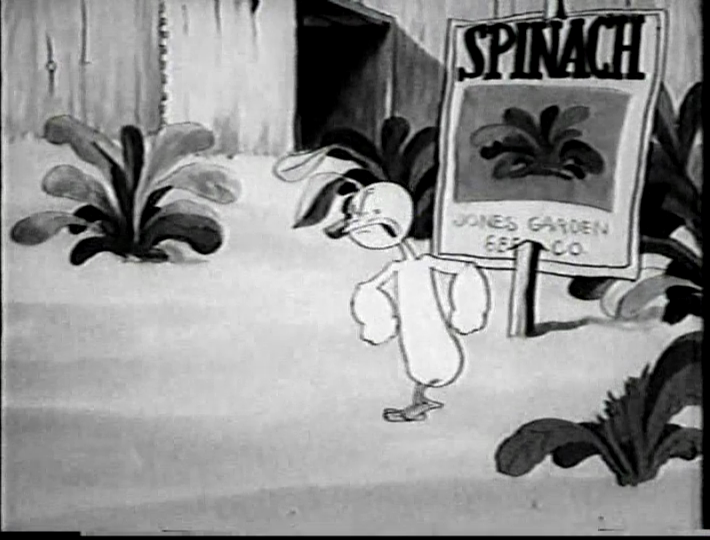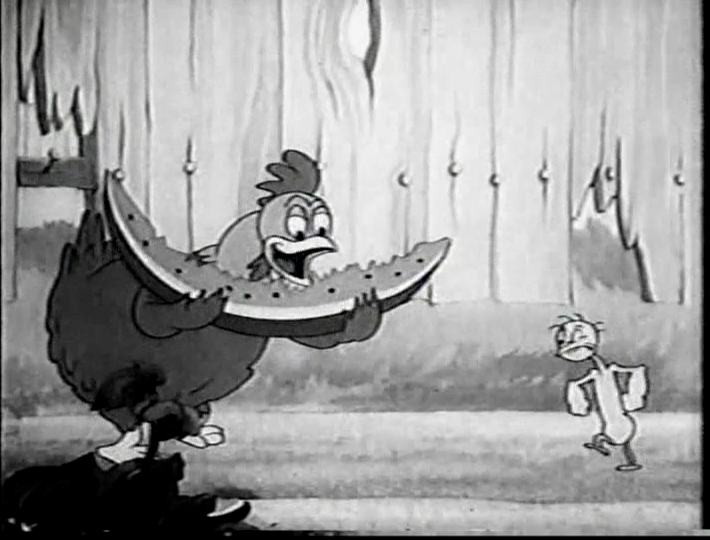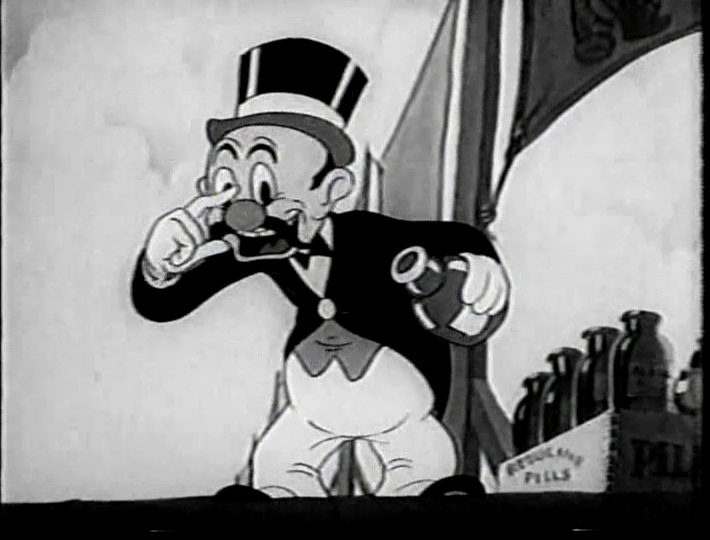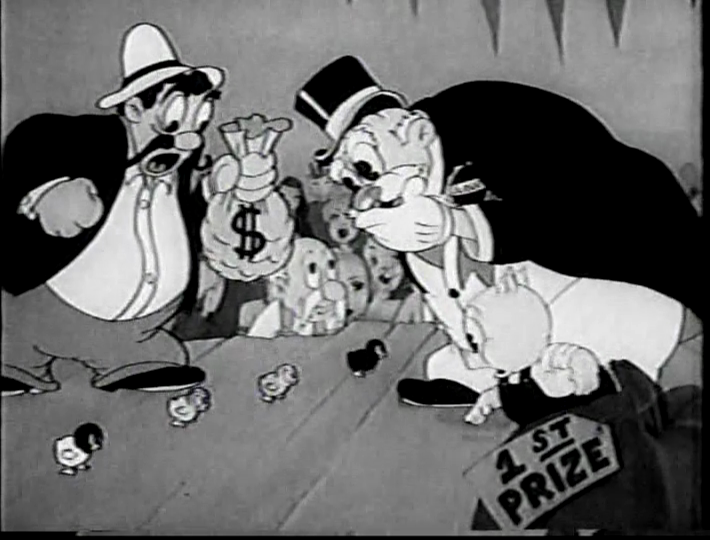DVD/BLU-RAY AVAILABILITY: Porky Pig 101 (WHV 5-DVD set; the version there is butchered)
You can view a cruddy but acceptable print of this cartoon HERE.
Thanks to our good bud Devon Baxter for hosting this cartoon. Devon has a great collection of classic cartoons online, and a visit to his YouTube account will yield hours of enjoyment.
The Avery unit has been in free-falling flounder for its past few cartoons. Despite a dearth of great ideas, Avery and his crew have been polishing up their act, as the look and feel of animation--and its increasingly faster pace--ramps up for the 1940s.
Porky's Garden is a fond step backwards, to the more innocent days of 1936. Avery had less front-office pressure as he and his talented crew cranked out lower-budget black-and-white "Looney Tunes."
And while this cartoon is as bankrupt of great ideas as Avery's last few--it is, indeed, the weakest of his black-and-white cartoons, until 1941's The Haunted Mouse--it proceeds in a cheerful, harmless way. It offers glimpses of the coming sophistication to the visual aspect of Hollywood animation.
The cartoon's opening bit harks back to the Avery unit's debut film, Gold Diggers of '49. This may seem intentional to our modern eyes:
The sequence has more humor (and a quicker pace) than the 1935 cartoon, but it's one of many curious throwback aspects to Porky's Garden.
This cartoon is an oddity in the Avery canon. Avery was not one given to fond looks back. Later in life, he was reluctant to discuss "the old stuff" with younger animators. In his career, Avery zealously re-used ideas, characters and gags, but never with a sense of nostalgia.
The most jarring broken link to forward movement, here, is the complete absence of Avery's new star animator Irv Spence. We have nothing but guesstimates, beyond a few fragments of interview memoirs, as to why things happened at the Schlesinger studio.
The lack of Spence's more dynamic, energetic animation suggests a conscious attempt to NOT make this look like a modern cartoon. Only its staging and cutting occasionally brands the film as Avery's 1937 work. Its look and feel often coasts back to the nine earlier black and white Porky Pigs of 1936.
Back to the play-by-play. In many classic cartoons, sign=chance for income tax gag. In cartoons from the late 1930s, it means killing about 40 seconds while holding on the sign for dear life.
Porky, now a rural bumpkin, stutters excitedly about his potential prize-winning garden.
Condescending, stereotyped Italian neighbor (voice actor ID revealed at end of post) disagrees. "I gonna win weeth my CHEEKIN!"
Leapfrog as humiliation tool is "Guinea"'s exit strategy. 1933 white dog, in background, watches scene with amusement.
Pig double-exposures himself exit stage left.
An overhead shot recalls similar scenes in the earlier black-and-white pictures.
"Guinea" attempts modern science to beef up his poultry. He clearly has no idea what he's doing, but he feels self-assured as he babbles and pours:
For no good reason, we cut back, briefly, to Porky, who's done with the tail-sticking bit.
It's right back to "Guinea," and his nutritional cheekin feed-a.
The expression in the frame below is spot-on. This smacks heavily of Avery's hand as a cartoonist. His personal touch has gone missing since Uncle Tom's Bungalow, his last cartoon of any real note or worth. It's nice to see his drawing style back in his own pictures.
So much for doing things the legal way.
Back to Porky. To the tune of "Carolina in the Morning," he uses hair-growth tonic to stimulate his veggies:
One is reminded of Avery's 1947 film King-Size Canary. How clumsily and slowly this sequence unfolds, compared to the flat staging and high tempo of that later film, speaks to Avery's development as a film-maker. The Avery of '47 would have given two quick shots to this scene. His 1937 skill-set embraced live-action cinema technique to a sluggish degree. While he was capable of rapid shots and cuts, as we've seen in earlier 1937 cartoons, his tempo here is limpid.
One injection of hair tonic brings seismic shifts and remarkable results. The ghost of Porky the Rainmaker is in this scene:
Instant prize-winning spread! Porky is joyous. He sings "vo-do-de-o" and "boop-oop-a-doop" (accurate period music for 1927) as he shuffles off to bungalow.
"Guinea" is no dope. He finds the answer to his problem of how to make the chickee grow-a.
This animator's take on "Guinea" has rich, expressive acting. Having such a great voice track inspired better work from Avery's staff. In this scene, the look and feel leans heavily towards the future of animation.
The old loose board routine...
Now let's have some eating gags--many of them variants on business from Porky the Rainmaker--as the chickens devour the pig's hair tonic-infused work.These things come in threes. Typically, #1 is reasonably funny, #2 is lame and #3 delivers the boffo laffs.
Reasonably funny: tomato vine becomes straw, as luscious fruit are sucked dry.
Lame: belabored set-up for dull pea-shotgun bit.
The third bit offers the biggest laugh in the entire picture. A 16mm copy of this cartoon was the first print I ever owned, some 35 years ago. I ran this many times in Moore Auditorium, where the FSU student film series. This never failed to amuse any audience, and is the one moment in Porky's Garden worthy of Fred (or Tex) Avery's name:
Stick-figure chick whines about the inequity of life...
...encounters spinach (from the Jones Garden company, BTW)...
...and, to the tune of that Carl Stalling favorite, "We're Shovin' Right Off For Home Again," chick turns into a Popeye simulacra, Mercer-esque mumbles and all.
Chick regains possession of watermelon.
I still have that old print of Porky's Garden. It has not seen a projector's rays in 25 years.It's almost all downhill from here, but let's keep going. Here's a favorite Avery gag, scored to another Stalling bugaboo, "In The Shade of the Old Apple Tree."
Avery's hand again dominates the layout and animation look and feel. Stalling's sluggish tempo slows this scene down--he was learning his art here, too.
We fade to black--then back up to a pig's eye view of garden chaos.
Pig is not pleased by poultry's plunder!
Gotta get that broom.
Ineffective shooing commences.
Pissed pig stands up for his garden's rights. "Guinea" denies all accusations.
The voice actor's performance (from 4:07 to 4:32 in the cartoon) is sublime. It inspires a top performance from Avery's animators. If this cartoon backslides on innovation, it charms us with its rich characterization.
Cutaway demonstrates that the chickens aren't even aware "Guinea" is talking to them.
As can be intuited in these screen-grabs, Porky is overwhelmed by "Guinea"'s motor-mouthing. He's too stupefied to be angry, sad or proactive.
"Guinea" is pleased with the outcome. "At'za too bad..."
"but not... too bad!"
Stunned, Porky finds a last thread of hope... more like an umbilical cord!
Here's this edition's pasted-together pan shot, as Porky traces the vine to a wondrous sight...
A p-p-p-perfect pumpkin!
At least there's something to show for all this chaos.
A Harold Lloyd/Buster Keaton sports gag follows. Avery loved to crib bits from older comedies.
The naturally occurring goal post is a clever touch.
Some thrill comedy, as Porky almost loses his garden gem, leads us to another small sign of life in this picture.
"Guinea" gathers his hefty hens.
Destination:
Porky and pumpkin arrive first, followed by his arch-rival/poultry.
Carnival banners=opportunity for staff caricatures/some racy stuff. Who is the Living Skeleton supposed to be, I wonder?
Avery has not forgotten that cartoons ought to be fun, so, thanks to the voice artistry of Earle Hodgins (more about him below), we get a downright wacky, Clampett-esque moment, and some zany sight gags. Thank God.
"The reducing pill to end all reducing ills!"
Fleischer-esque "moving holds" are always welcome in cartoons.
Poetic transformation, with beautifully bemused facial expression from pachyderm:
Whoever animated this scene gave it his all.
The sped-up soundtrack is inspired. (See 6:24-6:36 in video, please.)
The effeminate "woo!" is a perfect finale for this brief dip into cartoon madness.
As the barker vends pills, promising a "size 32 waistline," he spills some of his product into the path of the fattened fowl. As in Porky the Rainmaker, the birds instantly gobble these life-altering drugs.
Judge is about to award Porky the prize.
Fickle judge rescinds award.
"Guinea"'s chickens seem destined to take the gold. They have that distinctive over-stuffed look that is a tell of Avery's hand as cartoonist. Again, a modern viewer might flash on the grotesquely overgrown animals of King-Size Canary in this moment.
Enter poetic justice.
Iris out--or is it? Porky's pissed expression tells us all is not signed, sealed or delivered.
Twin portholes open. Porky leans up out of his to reclaim that $ sack.
"Guinea" exhibits temporary hubris. Irises out!
Keith Scott, peerless authority on voice artists for movies, animation and TV, shared some of his knowledge with me.
In the interest of clearing up bad Internet information, I quote Mr. Scott now. "The neighbor voice was done by Italian character actor George Humbert. Avery hired him from his movie roles (Clampett said Tex would would go to movies and listen to radio for voice ideas). The salesman voice is Earle Hodgins, and he WAS on the radio doing that patent medicine character."
George Humbert was in many classic Hollywood films of the 1930s and '40s, including one of its most sublime comedies, Ernst Lubitsch's 1932 Trouble in Paradise, in which he shares an opening scene with star Herbert Marshall. Like Fortunio Bonanova, Humbert specialized in comic/sentimental Italian characters. He can be seen in more significant roles in 1931's Street Scene, 1933's The Mayor of Hell and 1937's Heidi and Dead End.
Most often, he played easily vexed waiters, barbers, chefs and other subservient roles. His performance as the nameless neighbor is a highlight of Porky's Garden. His voice work has real charm and authority, He gave Avery's animators something truly special to bring to life. It's too bad the cartoon is so mild and uneventful.
Humbert's presence is proof that Avery closely studied Hollywood's live-action output, with an eye for ideas and potential talent. To better turn film-making inside out, Avery had to first know and embrace its foundations and limitations. His seems a fan's familiarity at times--until he turns on that seeming charm and guts it, as often happens in his best work.
If Porky's Garden doesn't amount to much, it is a quick, amiable walk down recent memory lane. It helps clear the deck for bigger and better cartoons in 1938. We have one more weak Merrie Melodie ahead, and then we'll have the luxury to explore a string of bright-to-brilliant Avery pictures.
UP NEXT: A So-So Sequel to "I Love To Singa," "I Wanna Be a Sailor"







































































































































































































For what it's worth, I actually prefer the ending here to the blander one a year later in Tashlin's Porky-versus-poultry effort "Porky's Spring Planting".
ReplyDeleteBut overall that cartoon it better paced and funner than this one, where there really isn't much to recommend it other than as Avery's final B&W effort for almost 3 1/2 years (though going by the Porky design here, Tex's unit seems to have done the animation on the Porky "Th-Th-That's all, Folks!" drum ending that debuted on the next Looney Tunes release, "Rover's Rival". It's a Clampett/Jones cartoon, but the end definitely isn't a Clampett/Jones design).
I hadn't seen the cartoon since I last reviewed it, but re-watching it again it definitely holds up well, and you've got to love Tex even at his most juvenile moments. The Popeye reference was just great!
ReplyDeleteMy guess for the absence of Irv Spence, was perhaps this cartoon was in production before Spence arrived at Schlesinger? It's only a theory, as Tex's previous shorts were all 'Merrie Melodies', and this short appears in between them. According to Tim Cohea (aka Sogturtle), Bob Clampett even claimed to have worked on 'I Wanna Be a Sailor' (whether he did story work, animation), but Irv's animation on that short as well as the cartoon's release date, appears to contradict Clampett's claim, but again, who knows...no easy answers.
Thanks to Keith Scott for clearing up the voice misinformation on the Italian guy [and to you too, Frank, for another well-written article!]. I had for many years thanks to guesses froim everyone that Charles Judels, Stromboli and the Cockney Coachman from Disney's classic "Pinocchio", was the gardener, but it isn't. Glad that Keith could clear another misconception [as Frank mentions, it's George Humbert as the neighbor.]
ReplyDelete